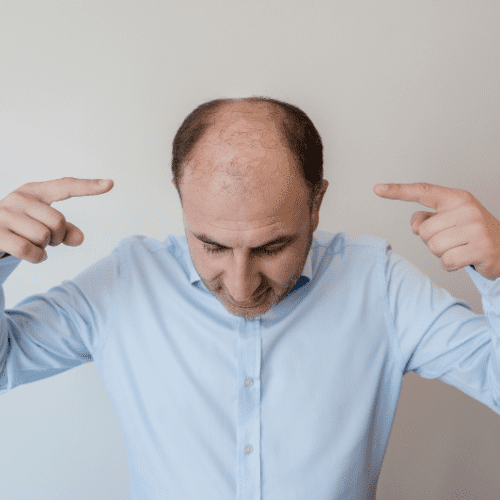Male pattern baldness, or androgenetic alopecia, is a common condition that affects a significant portion of the male population. Understanding the underlying causes of this phenomenon combines insights from genetic research, hormonal studies, and biological mechanisms. This article aims to provide a detailed examination of the genetic factors and hormonal influences contributing to male pattern baldness, equipping readers with knowledge about the condition’s complexity.
Understanding the Genetic Factors Contributing to Male Pattern Baldness: An In-Depth Analysis
The hereditary nature of male pattern baldness is a topic of considerable interest in genetic research. Studies have shown that the condition is primarily influenced by genetic predispositions, with a notable emphasis on the androgen receptor gene situated on the X chromosome. This gene is inherited from the mother, suggesting that maternal lineage plays a crucial role in determining the likelihood of developing male pattern baldness. Researchers have identified various polymorphisms and genetic markers that correlate with the onset of this condition, indicating that multiple genes are involved in its progression.
Furthermore, the sensitivity of hair follicles to androgens is a significant aspect of the genetic landscape of male pattern baldness. Variations in genes responsible for the androgen receptor, as well as other related genes, contribute to differing levels of sensitivity among individuals. This sensitivity determines how hair follicles respond to dihydrotestosterone (DHT), a potent androgen implicated in hair loss. Understanding these genetic factors not only sheds light on the predisposition to baldness but also opens avenues for targeted therapies aimed at modulating genetic expression and reducing the condition’s impact.
In addition to the direct genetic influences, environmental factors may also interact with genetic predispositions to exacerbate or mitigate hair loss. Lifestyle choices, nutritional status, and overall health can influence gene expression and receptor sensitivity, thereby impacting the severity of male pattern baldness. Recognizing the multifactorial nature of this condition is crucial for developing a holistic approach to prevention and treatment, ultimately leading to better management options for affected individuals.
The Role of Hormones and Other Biological Mechanisms in Male Pattern Baldness: A Comprehensive Overview
Hormonal factors, particularly the levels of dihydrotestosterone (DHT), play a pivotal role in the development of male pattern baldness. DHT is synthesized from testosterone through the action of the enzyme 5-alpha-reductase and is significantly more potent in its effects on hair follicles. When DHT binds to androgen receptors in susceptible hair follicles, it triggers a process known as miniaturization, which gradually reduces the size and lifespan of hair strands. This biological mechanism is central to the characteristic patterns of hair loss observed in men with androgenetic alopecia.
Aging compounds the effects of hormonal fluctuations, as levels of testosterone and DHT can change over time. It is during the later stages of life that many men begin to notice thinning hair and receding hairlines. The reduction in the overall efficiency of hair follicle regeneration, combined with increased sensitivity to DHT, leads to more pronounced hair loss. This section highlights the importance of understanding the interplay between aging and hormonal changes, as well as the potential for targeting these mechanisms with therapeutic interventions designed to stabilize or reverse hair loss.
Moreover, additional biological mechanisms, including inflammation and oxidative stress, may also contribute to hair loss in conjunction with hormonal influences. Emerging research suggests that inflammatory processes can damage hair follicles and disrupt normal hair growth cycles. Consequently, understanding the multifaceted interactions between hormones, inflammation, and genetic predisposition is essential for developing comprehensive treatment strategies that address not only the symptoms of male pattern baldness but also its underlying biological causes.
In summary, male pattern baldness is a complex condition influenced by a multitude of genetic and hormonal factors. The genetic predisposition primarily linked to the androgen receptor gene, combined with hormonal dynamics involving dihydrotestosterone, plays a critical role in the condition’s onset and progression. Understanding these intricate interactions provides a foundation for developing effective treatments and interventions. As research continues to evolve, it is imperative that individuals affected by male pattern baldness stay informed about potential therapies and lifestyle adjustments that may help mitigate their hair loss.




